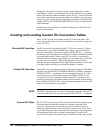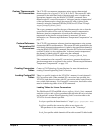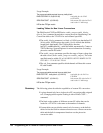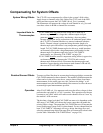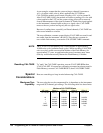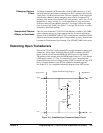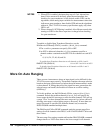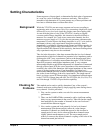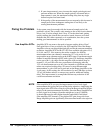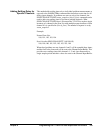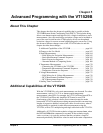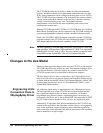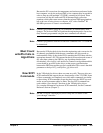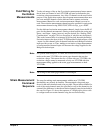
158 Programming the VT1422A for Data Acquisition and Control Chapter 4
4. If some improvement is seen, increase the sample period again and
perform another test. When the sample period is increased and no
improvement is seen, the maximum settling delay that any single
channel requires has been found.
5. If the quality of the measurements does not respond to this increase in
sample period, then inadequate settling time is not likely to be
causing measurement problems.
Fixing the Problem If the system scans fast enough with the increased sample period, the
problem is solved. The system is only running as fast as the slowest channel
allows, but, if its fast enough, that’s okay. If, on the other hand, getting
quality readings has slowed the scan rate too much, there are two other
methods that will, either separately or in combination, have the system
making good measurements as fast as possible.
Use Amplifier SCPs Amplifier SCPs can remove the need to increase settling delays. How?
Each gain factor of four provided by the SCP amplifier allows the Range
Amplifier to be set one range higher and still provide the same measurement
resolution. Amplifier SCPs for the VT1422A are available with gains of 0.5,
8, 16, 64, and 512. Now return to the earlier example of a difficult
measurement where one channel is measuring 15.5 volts on the 16 volt
range and the next a thermocouple on the 0.0625 range. If our thermocouple
channel is amplified through an SCP with a gain of 16, the Range Amplifier
can be set to the 1 volt range. On this range the A/D resolution drops to
around 31 µV per LSB so the stray capacitances discharging after the
15.5 volt measurement are now only one-sixteenth as significant and thus
reduce any required settling delay. Of course for most thermocouple
measurements, a gain of 64 can be used and set the Range Amplifier to the
4 volt range. At this setting, the A/D resolution for one LSB drops to about
122 µV and further reduces or removes any need for additional settling
delay. This improvement is accomplished without any reduction of the
overall measurement resolution.
NOTE Filter-amplifier SCPs can provide improvements in low-level signal
measurements that go beyond just settling delay reduction. Amplifying the
input signal at the SCP allows using less gain at the Range Amplifier (higher
range) for the same measurement resolution. Since the Range Amplifier has
to track signal level changes (from the multiplexer) at up to 100 kHz,
its bandwidth must be much higher than the bandwidth of individual
filter-amplifier SCP channels. Using higher SCP gain along with lower
Range Amplifier gain can significantly increase normal-mode noise rejection.



